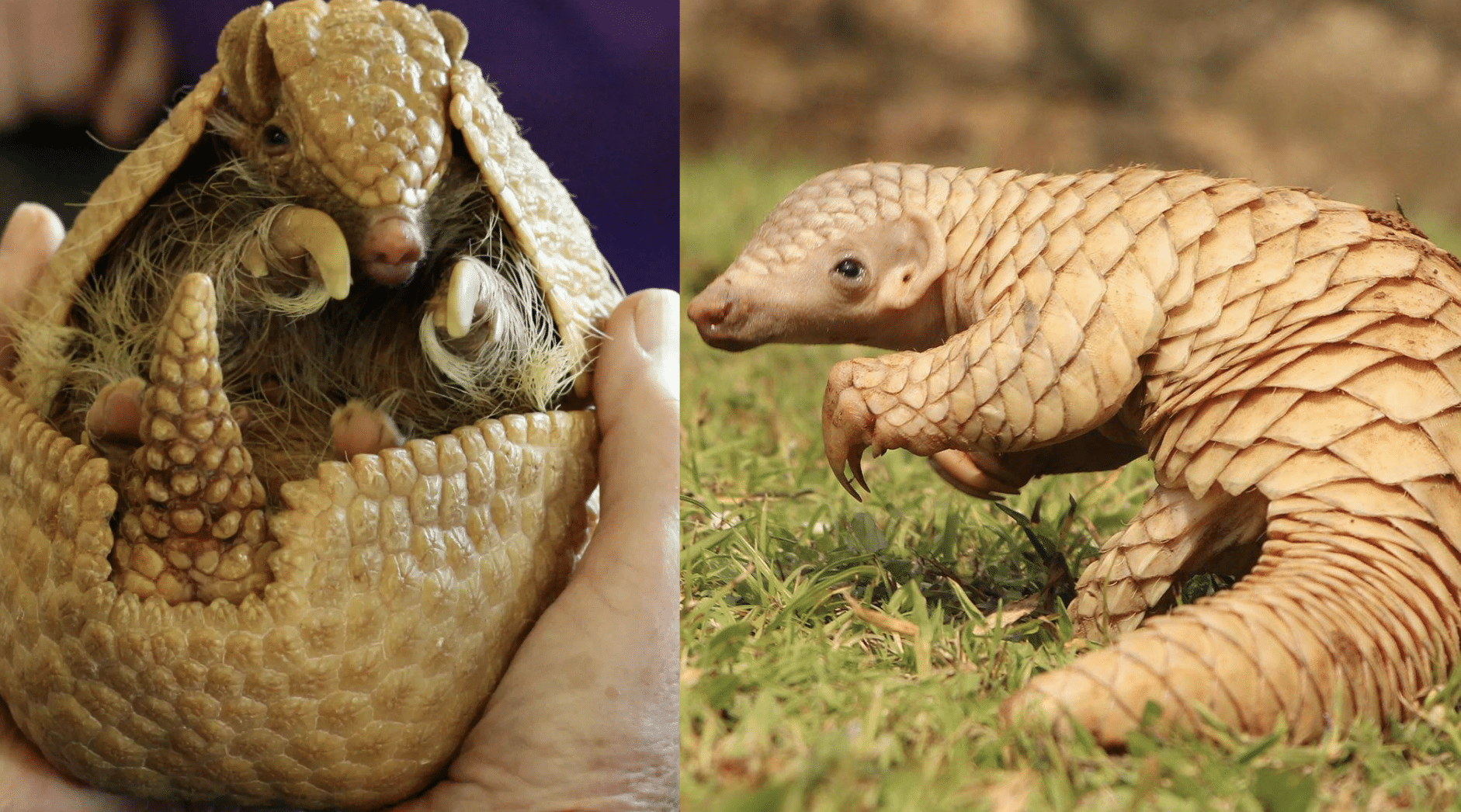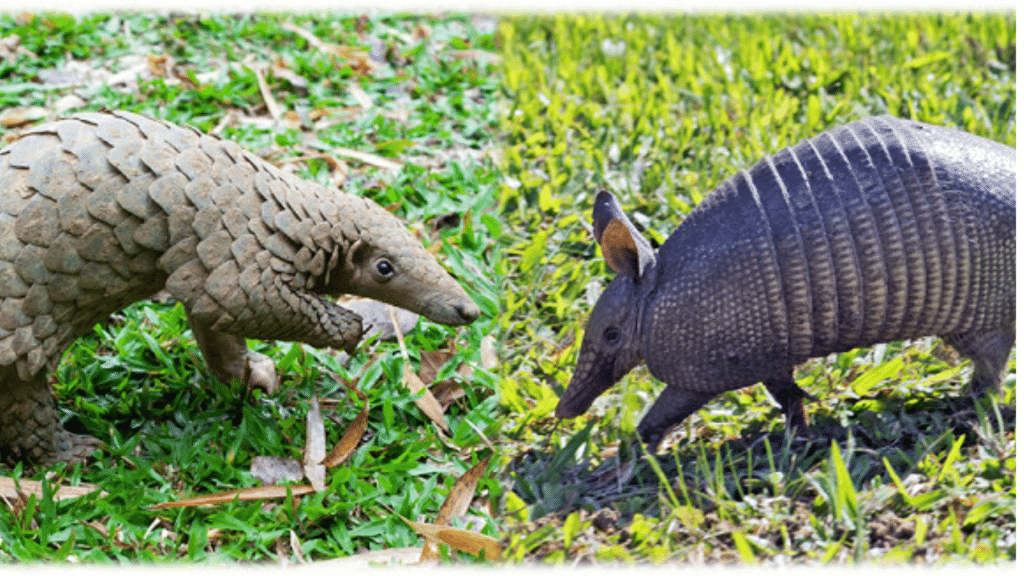Have you ever seen two animals that look alike but are actually very different? Pangolins and armadillos are a great example.
At first, they both have tough outer coverings and can curl up into balls. But that’s where the similarities end.
Because these two animals come from different parts of the world and belong to completely different animal groups.
They have developed similar features to survive in the wild, but in very different ways.
However, this blog will help you understand what makes pangolins and armadillos unique. From their body coverings and diets to where they live and how they move, we will cover all the ways they differ.
Differences Between Pangolin and Armadillo

Pangolins belong to the order Pholidota, while armadillos come from the order Cingulata, making them very distant cousins at best.
Let’s understand what sets these two armored animals apart:
1. Body Covering
The pangolin sports a coat of overlapping scales made of keratin, the same stuff as your fingernails.
These scales grow throughout their lives, accounting for approximately 20% of their total body weight. Each scale has a sharp edge, creating a protective layer that shields the soft body underneath.
The armadillo, however, wears armor made of bony plates called osteoderms. Flexible bands connect these plates and feature a thin skin covering.
The number of bands varies by species, with the nine-banded armadillo being the most common in North America.
2. Geographic Location
Pangolins Make Their Homes Across Two Continents:
- Africa: Four species live in various habitats, from forests to savannas
- Asia: The other four species spread across India, China, and Southeast Asia
- Range: Their territory covers from West Africa to the Philippines
Armadillos Remain Exclusive to The Americas:
- North America: Mainly the nine-banded armadillo in the southern US
- Central America: Several species across Mexico and countries southward
- South America: The greatest variety of species, especially in Brazil and Argentina
- Historical Range: Once only in South America before expanding northward
3. Flexibility
When threatened, pangolins can roll into perfect balls, with their scales pointing outward. This defensive position makes them look like living pinecones.
Their flexible scales overlap in a way that allows for this complete protection while making them difficult for predators to grab.
Armadillos have more limited flexibility. While they can curl their bodies somewhat, most species cannot form complete balls.
The three-banded armadillo is an exception; it can roll into a complete ball like pangolins. Most other armadillo species rely on running or burrowing for safety instead.
4. Diet Preferences
Pangolins are Specialist Eaters:
- Consume up to 70 million insects yearly
- Use their powerful sense of smell to locate ant and termite nests
- Break open nests with strong front claws
- Have no teeth, rely on stomach muscles, and stones to grind food
- They can close their nostrils and ears to keep ants out while feeding
Armadillos are Opportunistic Feeders:
- Dig for food using strong claws and a keen sense of smell
- Eat insects, grubs, and worms as primary food
- Add small vertebrates, plants, and fruits to their diet
- Some species even eat carrion when available
- Can consume toxic ants that other animals avoid
5. Species Diversity in Pangolins vs Armadillos
| Feature | Pangolin | Armadillo |
|---|---|---|
| Order | Pholidota | Cingulata |
| Family | Manidae | Dasypodidae |
| Species | 8 Total Pangolin Species | About 20 Different Armadillo Species |
| Evolutionary History | Ancient lineage dating back 80+ million years | Evolved in South America during its isolation as an island continent |
| Closest Relatives | More related to carnivores than to armadillos | Forms a group with sloths and anteaters |
6. Tongue Structure
The Pangolin possesses an extraordinary tongue that can extend up to 16 inches, which is longer than its entire body.
This remarkable feeding tool serves as the animal’s primary method for catching food.
What makes this tongue so special is its unusual anatomy. It actually attaches near the pelvis and the last pair of ribs rather than in the throat like most animals.
When hunting, the pangolin uses sticky saliva that coats its tongue to trap insects efficiently. After capturing prey, the tongue retracts into a special chest cavity designed just for this purpose.
The armadillo, by contrast, has a much more typical mammalian tongue. This more conventional mouth part extends only a few inches from the mouth when needed.
Unlike the pangolin, the armadillo’s tongue mainly helps manipulate food but doesn’t serve as its primary tool for gathering meals.
The armadillo tongue contains normal taste buds, which allow it to select and savor different foods in its varied diet.
When eating, the tongue works in conjunction with the teeth, a feature that pangolins lack entirely, to process food properly.
7. Reproduction
Pangolin Mothers Show Dedicated Parenting:
- Gestation Period: 120-150 days
- Typical Litter: Single baby (pangopup)
- Birth Weight: about 3-18 ounces (depending on species)
- Care Method: Baby rides on mother’s tail
- Protection: Scales begin soft but harden quickly
- Nursing Period: 3-4 months
- Independence: Achieved around 5-6 months
Armadillo Reproduction Varies by Species but Shows These Patterns:
- Nine-banded armadillos always have identical quadruplets
- Delayed implantation in some species
- Gestation: around 60-150 days (depending on species)
- Young armadillos (called pups) can walk within hours of birth
- Mothers nurse babies for 2-4 months
- Sexual maturity is reached in 1-2 years
- Some species, like the nine-banded, can store sperm for later fertilization
Final Thoughts
While pangolins and armadillos may seem similar at first glance, their unique features and behaviors set them apart.
Both animals are interesting examples of nature’s creativity. They use their tough exteriors for protection in their own ways.
But understanding their differences will not only help you appreciate them more but also emphasize the importance of preserving these amazing creatures.
So, the next time you encounter one, you’ll know exactly what makes it special.
If you found this blog insightful, feel free to share it and help spread awareness about this interesting animal!















